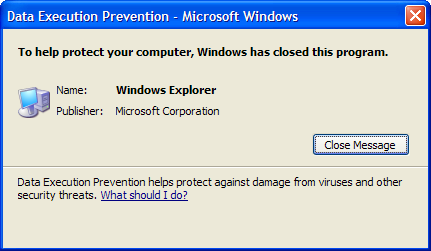The best way to turn Off DEP (Data Execution Prevention): Sometime Data Execution prevention triggers a mistake and in that instance it very important to turn off it and within the following guide, we’re going to see precisely how to turn off DEP.
Harmful programs can attempt to attack Windows by attempting to conduct (also called perform ) code from program memory locations reserved for Windows and other authorized programs. These kinds of attacks may harm your files and programs.
DEP can help protect your Computer by tracking your programs to be certain they use system Memory. If DEP notices a program on your computer using memory Incorrectly, it closes the program and notifies you.
You can easily turn off Data execution prevention for a particular program by the following steps below:
NOTE: DEP can be turned off globally for the entire system but it’s not recommended as it will make your computer less secure.
1. How to turn Off DEP (Data Execution Prevention)
1.Right click on My Computer or This PC and choose Properties. Then click on Advanced system settings in the left panel.

2.In Advanced tab click on Settings under Performance.

3.In the Performance option window, click on Data Execution Prevention tab.
Now you have two options as you can see, by default DEP in turned on for essential Windows programs and services and if the second one is selected, it will turn on DEP for all programs and services (not just Windows) except those which you select.
4.If you are facing issues with a program then select the second radio button which would Turn on DEP for all programs and services except those you select and then add the program that is having the problem. However, DEP is now turned on for every other program in Windows and you might end up where you started i.e. you may start having the same problem with other Window programs. In that case, you have to manually add each program that is having a problem to the exception list.
5.Click the Add button and browse to the location of the programs executable you want to remove from DEP protection.
NOTE: While adding programs to the exception list you might get an error message saying “You can not set DEP attributes on 64-bit executable’s” when adding a 64-bit executable to the exception list. However, there is nothing to worry about as it means your computer is 64-bit and your processor already supports hardware-based DEP.
Your computer’s processor supports hardware-based DEP means that all the 64-bit processes are always protected and the only way to prevent DEP from protecting a 64-bit application is to turn it off completely. You cannot manually turn off DEP, in order to do so you have to use the command line.
2. Turn DEP Always On or Always Off using Command Prompt
Turning DEP always on means it will be always on for all processes in Windows and you cannot exempt any process or program from protection and turning DEP always off means it will be completely turned off and no process or program including Windows will be protected. Let’s see how to enable both of them:
1.Right click on the windows button and select Command Prompt (Admin).
2.inside cmd (command prompt) type these following commands and hit enter:
To always turn on DEP:
bcdedit.exe /set {current} nx AlwaysOn
To always turn off DEP:
bcdedit.exe /set {current} nx AlwaysOff
3.Note that there is no need to run both of the commands, as shown above, you only need to run one. You will also need to restart you PC after any change you made to DEP. After you have used one of the above commands, you will notice that the windows interface for changing DEP settings has been disabled, so only use command line options as a last resort.
That’s it you have successfully learned How to turn Off DEP (Data Execution Prevention). So this is all we can discuss DEP, how to turn DEP off and how to always turn DEP on/off and if you still have doubt or question regarding anything feel free to comment.
